Let’s admit it: When picking a hotel for a trip, our choice often depends on reviews left by previous clients. Many guests will gladly post a photo taken on the hotel premises and tag the location showing the world the lovely accommodation. Peer recommendations can also make a difference when settling on a restaurant for dinner, or sights worth seeing. All these examples show how much impact user-generated content (UGC) has on our travel experience.
Word of Internet has become an alternative to word of mouth. Surfing the web, we constantly bump into user-generated content, oftentimes even contributing to it. UGC is an umbrella term for any form of media - videos, blogs, reviews, images, audio files, etc. - that was posted by consumers to be publicly available at online platforms.
People are more inclined to trust content made by others than a brand’s professionally written narrative. Why would peers misrepresent a place, we wonder. One of the most popular hotel alternatives, Airbnb, made a review feature their key trust mechanism proving that even a stranger’s opinion can be more valuable than a company’s sales pitch.
There are three ways for customers to share their content. Each type requires its own approach and has its own limitations:
Social media. Here, you can grow your audience quickly and easily engage them in campaigns. Twitter or Instagram already provide a lot of opportunities; however, it means that you can act only within their structured rules. Besides, the only benefit here is brand visibility, and it's rarely visibility you can control.
Review websites. TripAdvisor and Foursquare alike have a broader functionality than social apps and an existing community of avid review sharers. These unbiased reviews, unfortunately, don't allow you to react to and fix the issues quickly.
Owned channels. This is your website or an app. Here, you have the full freedom to engage your users as you see fit, keep them on your platform, and introduce unique features and UX decisions. Further, we'll give you tips on working with UGC on an owned channel.
UGC is a driving force of content marketing and it’s definitely a strategy travel brands can use to their advantage. First, we’ll explore the importance of user-generated content in the travel industry and then provide best practices for UGC.
The value of user-generated content for travel companies
When it comes to such a highly competitive industry, it’s harder than ever for travel brands to stand out. How can a single travel brand produce enough content to stop consumers from checking out what the competition is offering?
In this case, user-generated content allows travel companies to capture consumer attention and create more authentic experiences. In fact, the Bazaarvoice report states, “In 2017, the conversion lift from UGC jumped to 106 percent, marking a 3.9 percent year-over-year increase.”
Not only does UGC increase conversion, but it also helps brands identify their typical customers and prime use cases, alerting them to any flawed services that need mending.
We’ll list the key benefits a travel company can get from applying UGC strategy to their business, and then you decide for yourself.
Satisfy consumers expectation. Looking for recommendations in travel is becoming a big thing, especially for millennials. That age group reads around 11 reviews before they feel ready to commit to a booking. In 2018, there’s been a marked growth in the number of reviews the average consumer reads. As BrightLocal’s survey reports, “Now, 70 percent of consumers read 4 or more reviews before trusting a business.”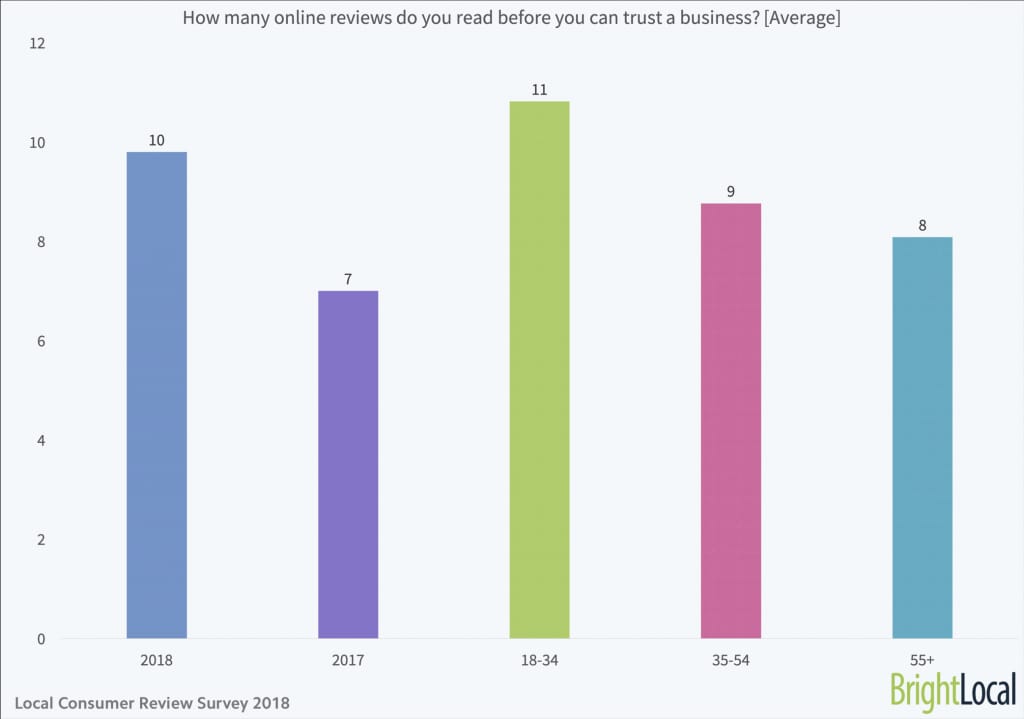
The number of reviews people of different ages read to trust a business, average indexes in 2017 and 2018. Source: Local Consumer Review Survey by BrightLocal
Get more exposure. Exploding across all media platforms, UGC helps drive more traffic to brand websites, which ultimately spreads awareness of a travel brand. Needless to say, an increase in social engagement will lead to an increase in booking and then to overall revenue.
An industry survey by Rezdy called Tour Operator Trends for Booking Channels rated review websites (e.g. TripAdvisor) second among the highly effective channels for increasing a business’s visibility and bookings, followed by word of mouth.
Collect relevant content. Instead of creating content, a UGC strategy creates opportunities for content creation: campaigns, contests, etc. By means of user-generated content, travel companies are able to realize maximum content despite budget constraints. For example, using UGC in their #TravelForReal campaign, Loews Hotels generated thousands of guest-posted images that they could then repurpose in magazines and on booking pages.
Have more impact on the decision making. Statistics from the Expedia survey Traveler’s Path to Purchase show that “online travel bookers increasingly engage with travel content throughout the weeks preceding a booking event.” That said, on average, it takes six weeks for US travelers to choose a hotel, and they visit many hotel and resort sites during that time. That means, in those six weeks of decision making, any detail might become an influencer in their final verdict.
Sometimes consumers may not even realize how strongly user-generated content affected their trip decision. UGC is a tool to tip the scales in your favor. A survey by TurnTo Networks also adds to this point with 90 percent of the analyzed consumers reporting UGC to be more influential on their buying decisions than promotional emails and even search engine results.
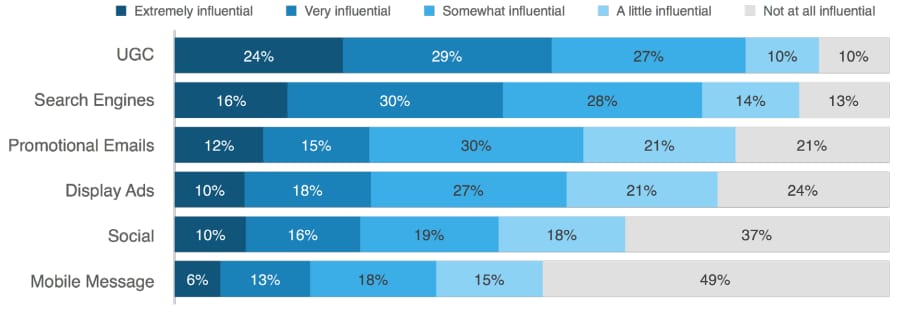
Set the booking cycle. When one person’s trip ends, another’s starts. Realizing that their past customers are now their best advertisers, travel brands can set off continued marketing efforts: By sharing content about a travel brand, past guests inspire new ones to go on a similar trip. And the booking cycle starts over.
Many tour operators are now moving away from marketing investments. Instead, they are promoting positive customer experiences, working with review websites, and actively advocating feedback on social media channels. If used correctly, UGC can help nurture a strong bond between consumers and the brand. Understanding that, Hyatt Hotels do their best to offer guest-centric digital experiences that keep their customers coming back. They launched a hub of real travelers’ photos showcasing their experiences while staying at brand properties.
Let’s assume that by now you’re persuaded that user-generated content is worth your attention. Now let’s get to the point – best UGC practices that will work.
Feedback — the UGC type that travel needs
It’s hard to deny the effectiveness of social feedback. It helps set consumer expectations. After checking out local business reviews, 53 percent of users typically make real visits to a business within 48 hours of search.
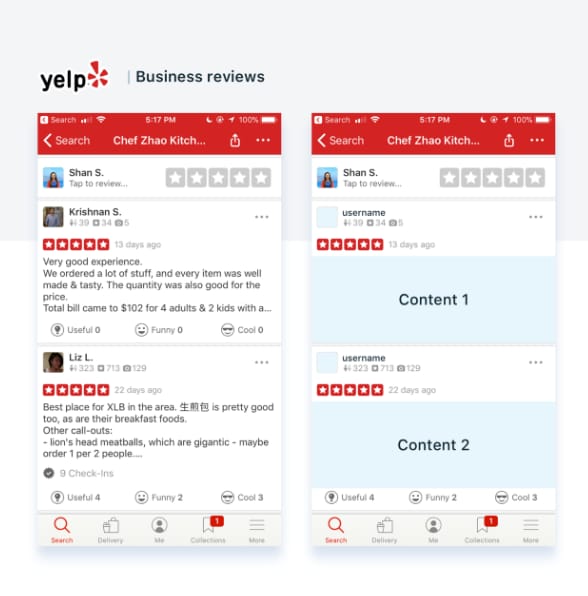
So, collecting UGC in the form of feedback, even the negative variety, deserves your time and effort. By drawing out the right conclusions, you improve your service and ensure that future ratings will rise. In fact, it’s a free way to assess your business performance, revealing guest expectations and how to better meet them.
Although, customers can leave reviews on social media and dedicated platforms, our main focus is on your own website or app as it is the place you have the most control of. So, there are many ways you can collect feedback at your website:
- conduct interactive surveys for users to fill out
- introduce a numerical rating or a star/emoji-based one
- ask for regular written reviews - a classic choice
- allow users to give quick tips or answer other users’ questions
- implement additional interaction elements such as “check-ins,” likes, photo adding, etc.
Now we’ll dive into the best practices to leverage the power of UGC feedback.
Best practices to foster user-generated content in travel websites
Surveys — make them quick and fun
Reach the right personas. To make sure your survey hits relevant users, set screening questions to help identify whether a respondent belongs to your target audience.
Use to the point questions. Limit the number of questions only to the most relevant ones showing a question per page. By no means should you make a respondent scroll up and down as it’s very annoying.
Diversify surveys. Getting a full picture of the customer experience and keeping the survey effortless for them is not an easy task. A way out? Diversify your survey, finding best layouts for different question types: multiple choice, yes/no, checkboxes, radio buttons, graphical representations, etc. In particular, presenting answers as pictures can be of great help to add comprehension to your survey.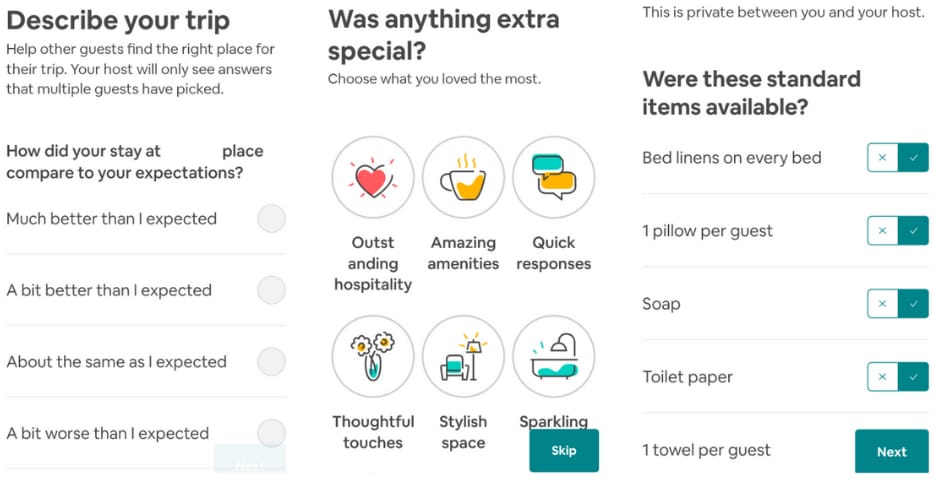
Host review survey at Airbnb has diverse questions
Include a progress bar. The length of the survey matters a lot as people tend to skip time-consuming tasks. It’s a good practice to keep the respondents informed how far they’ve come and how much is left in the survey. A visual scale located at the bottom of each page is the best decision as it won’t distract participants, but rather give an idea of where they stand.
Move open-ended questions to the end. Proposals, suggestions, and tips are better saved for dessert after a reviewer has been properly warmed up with closed questions. On completing an entertaining survey, a respondent is much more inclined to write a review as they’ve just run over their experience in their head. The memories are fresh again, so they have an idea of what to highlight.
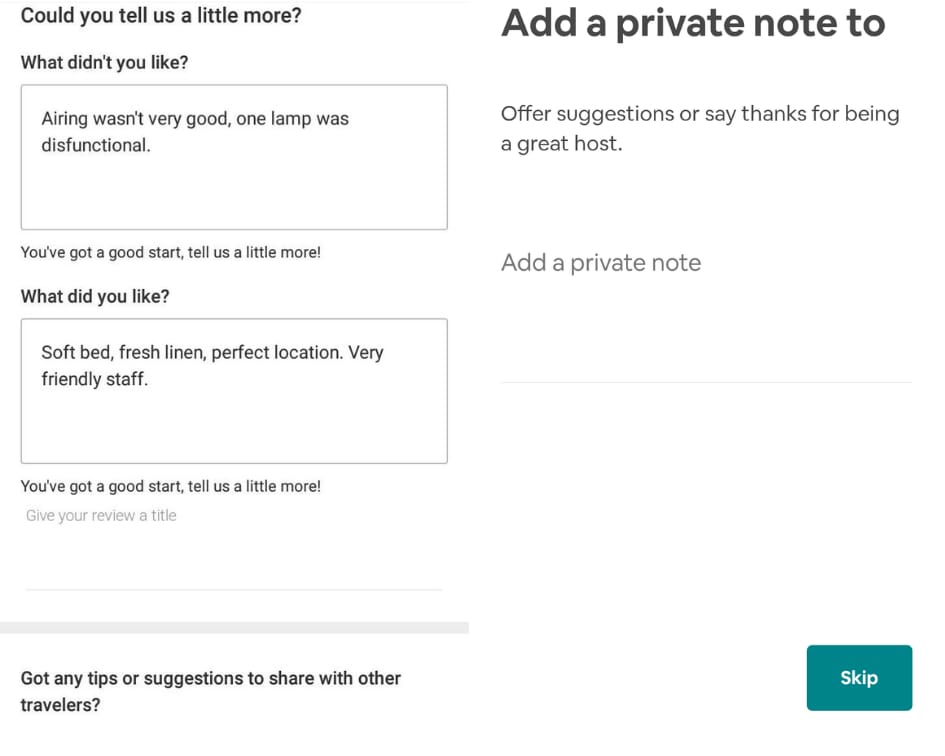
Design in-survey interactions. Work closely on visual effects and motion techniques for page transitions. This greatly contributes to the overall impression of the survey. Creativity will be surely appreciated by the respondents. You can read more on increasing customer engagement using site design and functionality in our article on this topic.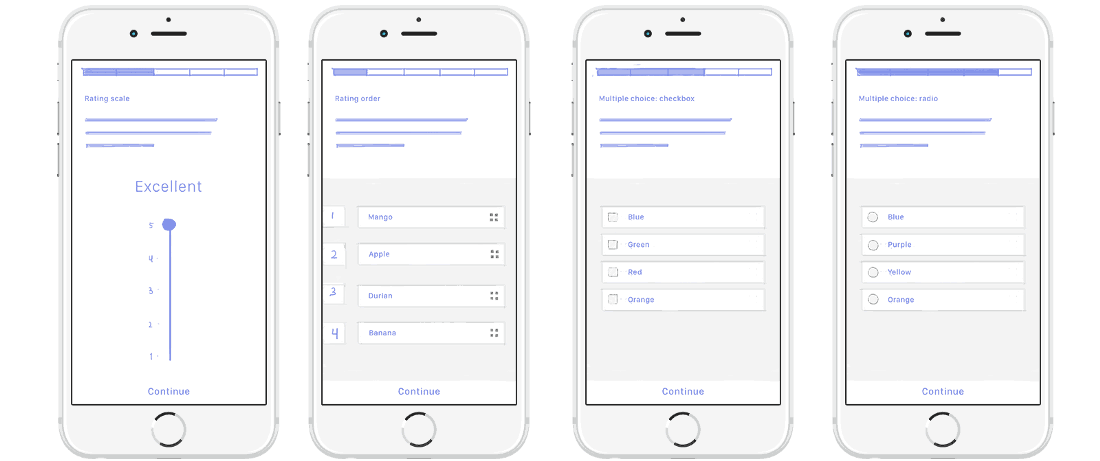
Interaction examples in a survey. Source: Budi Harto Tanrim
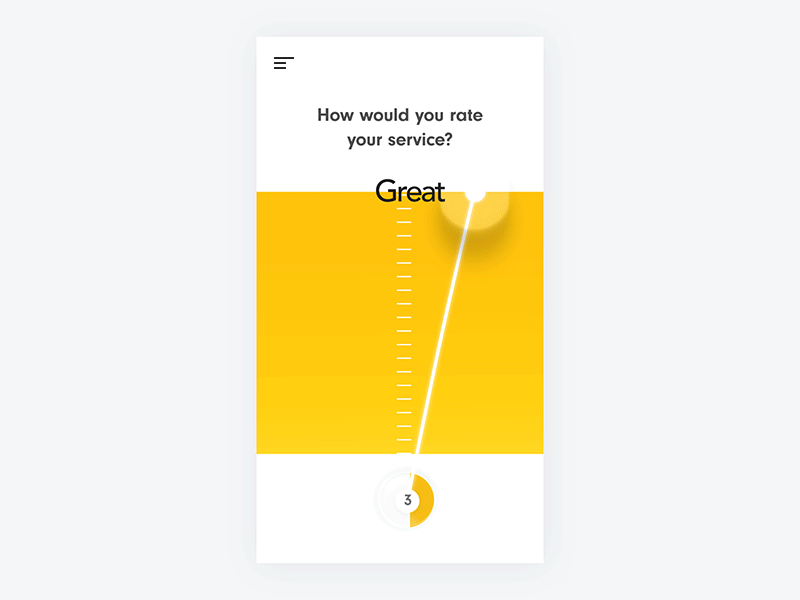 Mobile survey prototype. Source: Bilal
Mobile survey prototype. Source: Bilal
Set exit popup surveys. The right time for filling out a survey is when a customer is about to leave the website. An exit popup survey won’t interrupt your customer in the middle of doing something on the page. Incentivizing your respondent will motivate them to complete the survey and not just close the window.
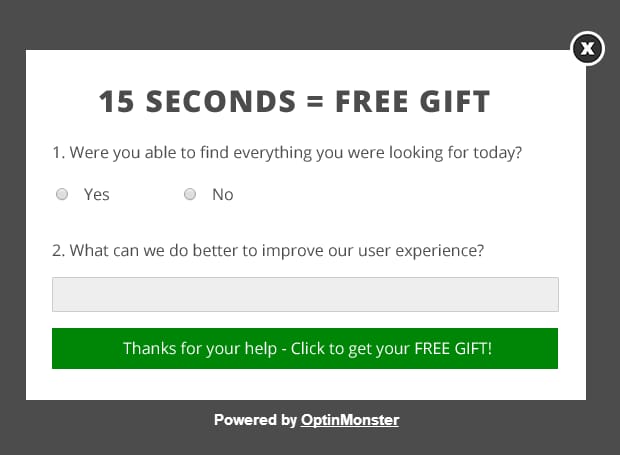
Ratings/reactions — worth a thousand words
Offer short and simple scaling. Instantly rating their overall impression won’t burden your customers, so they are more likely to respond. A good practice is to use five stars, smileys, thumbs up/thumbs down, or any other badges for scaling.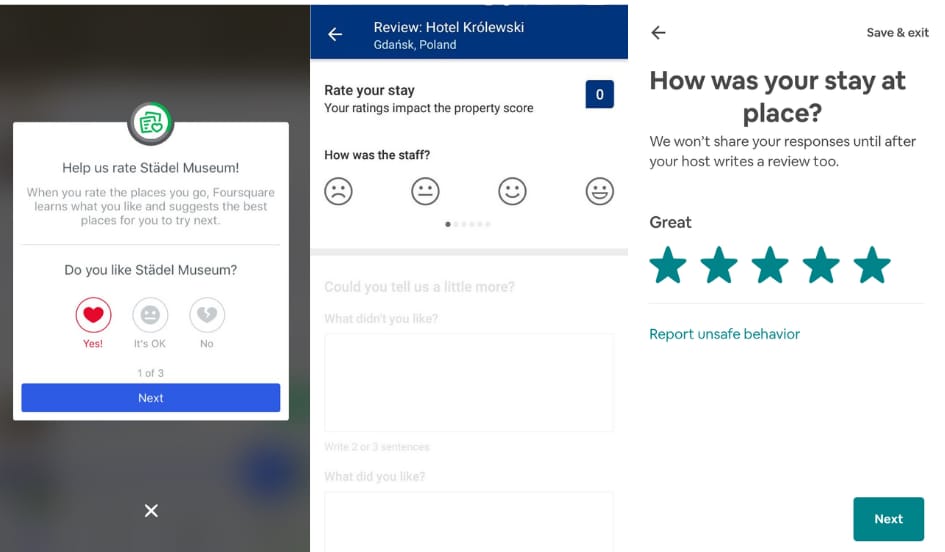
Examples of ratings by Foursquare,Booking.com, and Airbnb
Apply the Likert scale. Expressing the answer with an emoji is much easier. So, it's worth applying simple and straightforward emotions for scaling. Animating the emoticons is a great way to push the rating experience from painful and boring to entertaining and fun. Digging deeper, you may further ask why your consumers feel this or that way to get more valuable info from them.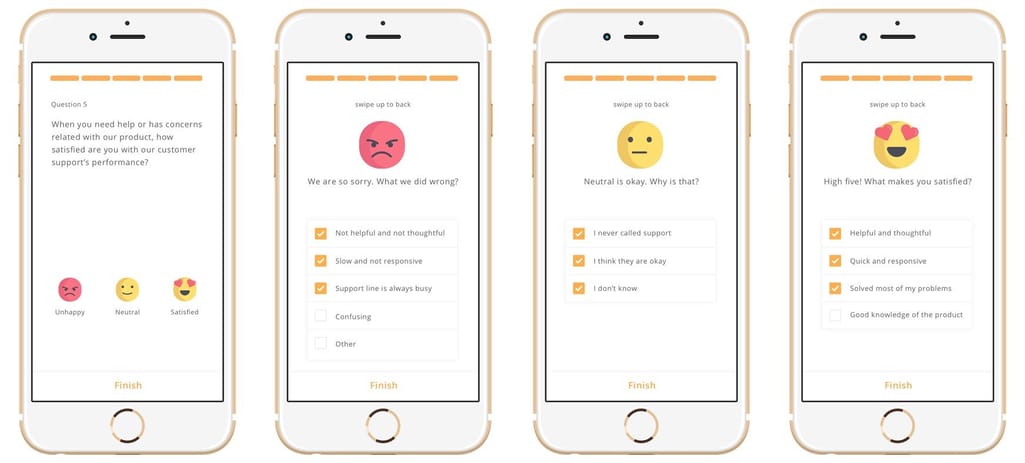
Emotional feedback with further questions to each reaction. Source: Budi Harto Tanrim
Written reviews — how to encourage to write more
Send review request emails. Reminder emails can be a great help in generating fresh reviews, building ongoing relationships with guests, and, in the long run, positively influencing your popularity ranking. Understanding this, TripAdvisor offers a tool called Review Express that permits composing and delivering bulk customizable emails intended to encourage guests to review your business.
Create a system of rewards. Implicit incentives can serve as a powerful motivation tool for collecting reviews as they make a user feel like an active member of the community. This can be statuses, badges, or levels within the site that a user earns for participation. Requiring little investment, social incentives can generate great value for your travel business. First, however, there must be a sizable existing community to engage.
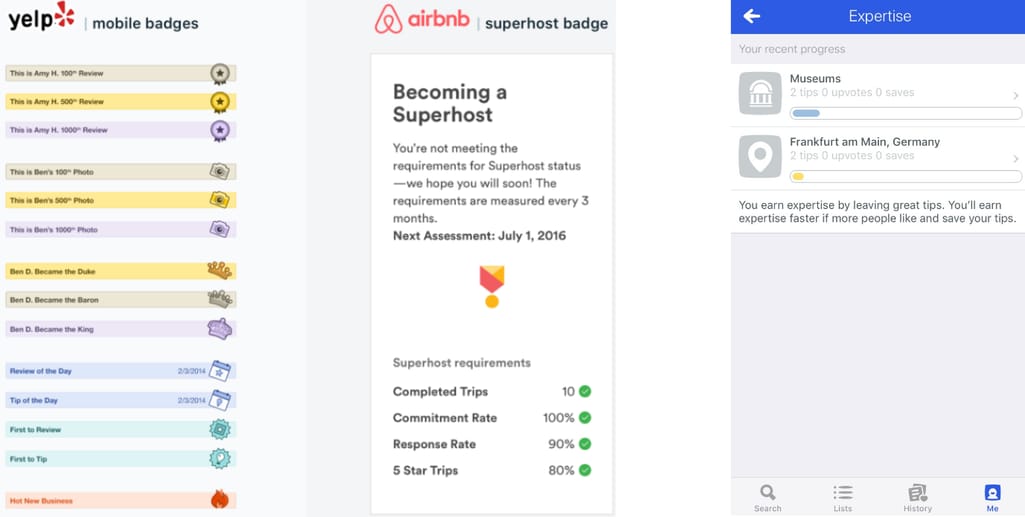
At Booking.com, they use a recognition system to inspire guests to leave reviews. On receiving a certain number of ‘helpful’ votes from others, a reviewer becomes a ‘Helpful Hero’. Long reviews are praised with a ‘Wordsmith’ title. A ‘Destination Guru’ is one who keeps contributing after visiting the same place more than once.
Handle positive and negative feedback separately. Surveys encourage satisfied users to write public reviews. Now it is important to have them wind up at your profile on review platforms. Make it as easy as possible for them by providing direct links. Contrarily, should a respondent happen to be unsatisfied, forward them to a private feedback channel. Chances are that by responding promptly to dissatisfied customers via a confidential feedback system and solving things out, they won’t leave negative public reviews.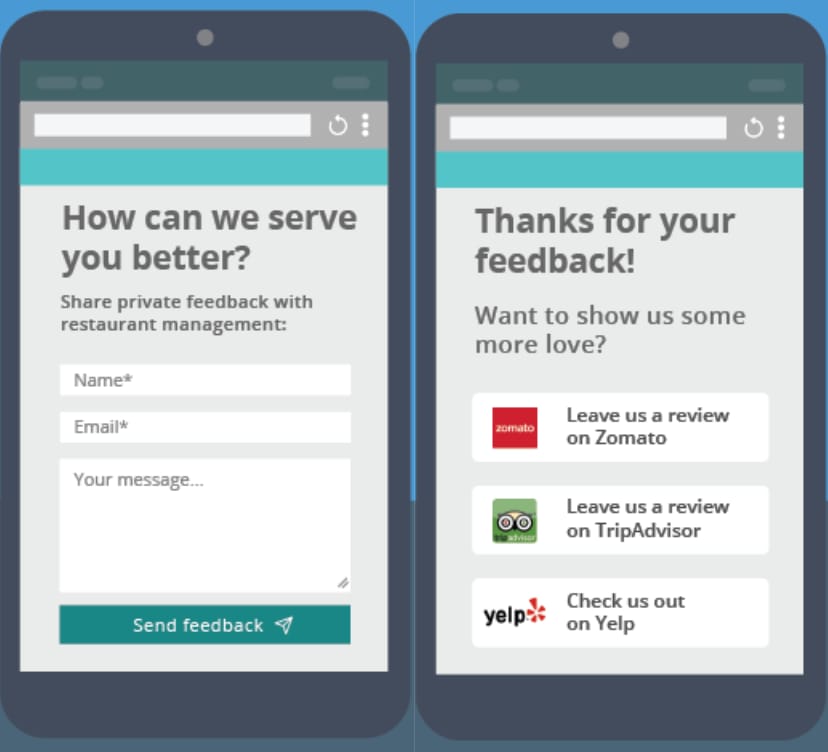
Separate handling of negative and positive reviews: private feedback channel vs links to review platforms. Source: Aislelabs
Other UGC types worth considering
Allow for visuals upload. Setting a campaign headed by a catchy and distinctive hashtag can help build a community encouraged to share their UGC visuals, thereby promoting the company’s brand.
Once you’ve set a campaign and it's started generating content, the next step is to make your website benefit from this visual UGC. You can embed feeds from social media and combine posted images on your website. Additionally, set upload forms to enable direct content contributions. An important point is how you present collected UGC visuals on your website, as it mainly determines how involved users will be. A good example is a dynamic map of Europe by European tour operator Busabout. Their website features are 90 percent UGC images, so they arranged the content in a digital map that visually demonstrates locations and user-generated photos taken there.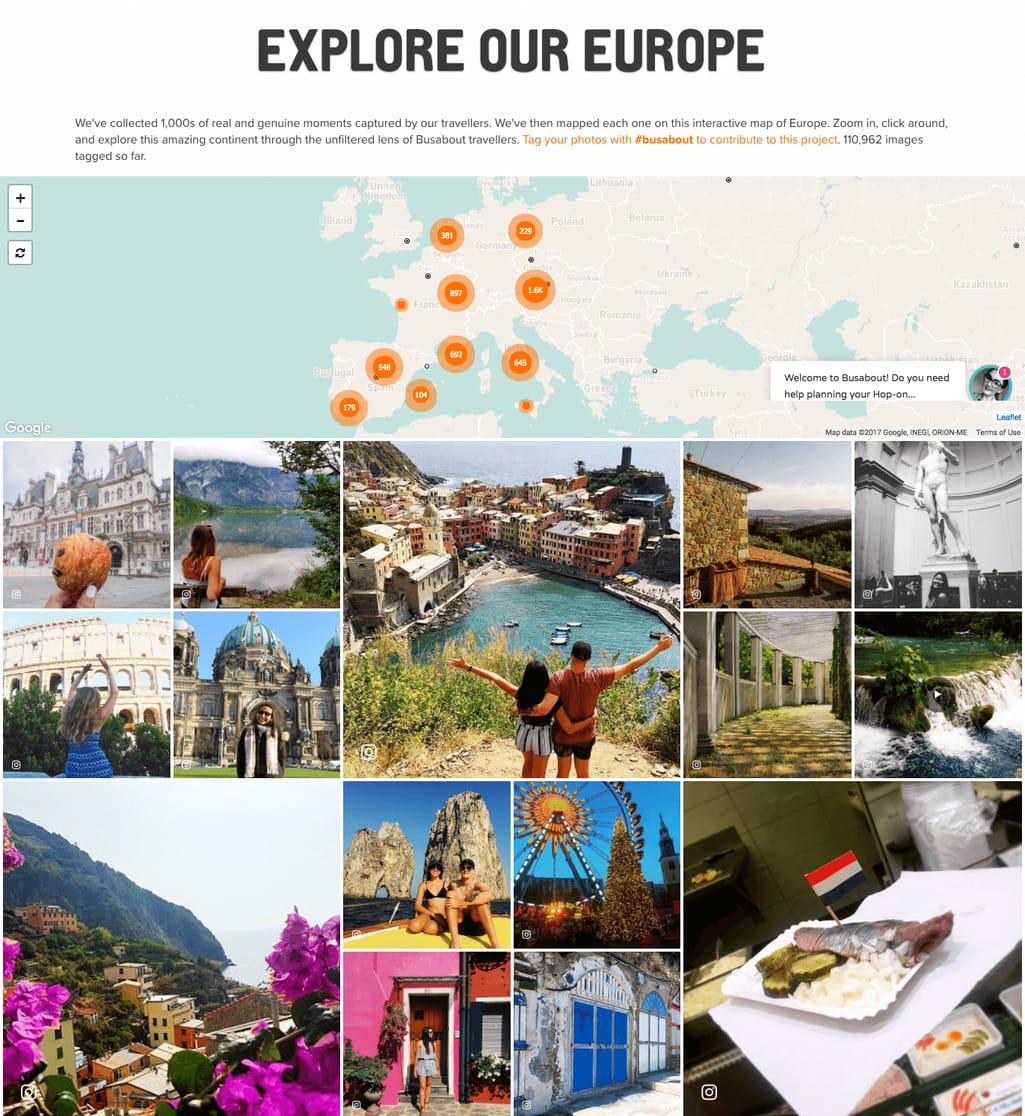
Busabout dynamic map
Add review widgets to your website. Once embedded in your website, a widget will display your ratings and awards gathered from a certain review site. You can set up what reviews to show and how they are to be seen. Providing info from other platforms, widgets help keep customers at your website and as a result, increase chances of direct bookings.
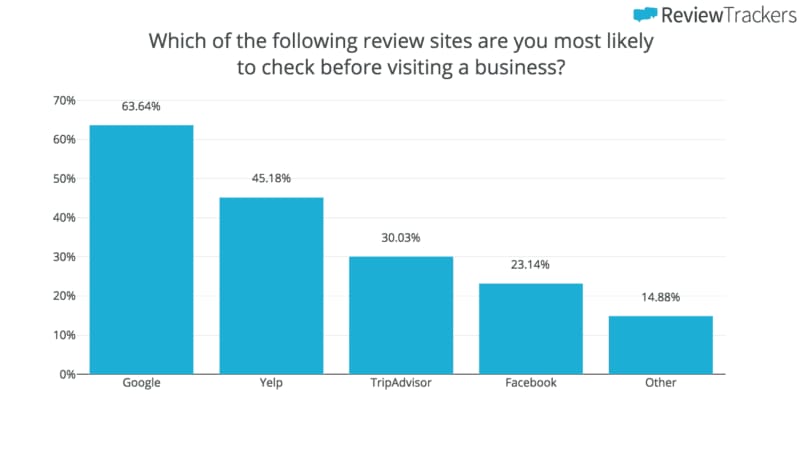
Additionally, customers will be able to leave reviews right on your website. For this purpose, make sure your widget is easy to locate. Many review sites offer widgets: TripAdvisor Widgets, Yelp Widget Pro.
Encourage check-ins for apps. When customers check in at your business, you get exposure to their friends and followers, which can help you earn valuable customer trust. Here are a few tips on how to encourage customers to check in when they visit:
- add check-ins to your website
- send out notifications asking to check in at your property
- post occasional reminders on your website prompting check-ins
- offer loyalty rewards for those who check in the most at your location.
General recommendations on handling UGC
Track down fake content. BrightLocal survey suggests that the increase in the number of fake reviews indicates that fakers are getting better at hiding them. We have a whole whitepaper dedicated to fraud detection, so you may want to check it out.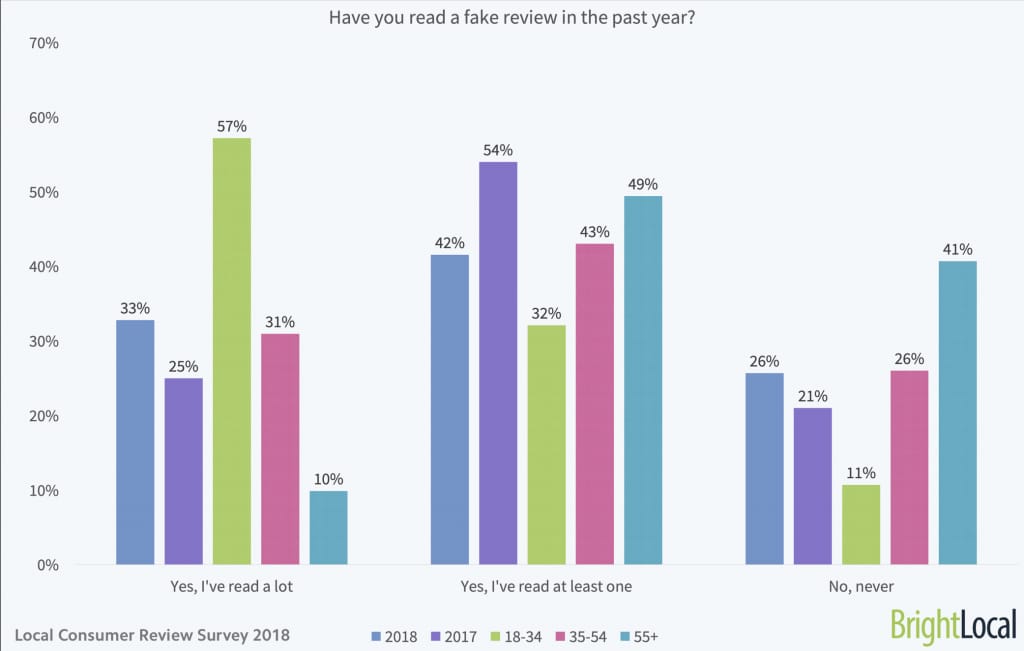
Fake reviews statistics. Source: BrightLocal
A good practice for dealing with a flow of biased reviews is setting guidelines that must be complied with. Interestingly, some companies have contradictory guidelines. While TripAdvisor encourages businesses to ask for feedback, Yelp penalizes those asking customers to review their experience on its platform. Meanwhile, both brands have strict policies against incentivized appraisal. TripAdvisor even has a dedicated team of fraud investigators tackling paid review fraud. If found guilty, TripAdvisor blacklists the reviewer’s account and marks the business account with a red badge. Other penalties include a loss of rankings in TripAdvisor searches and disqualifications from TripAdvisor awards. They also have a system that tracks and intercepts biased reviews.
Keep it up to date. Recent reviews are in high demand. According to the BrightLocal survey, the number of consumers solely impacted by reviews no more than two weeks old has more than doubled.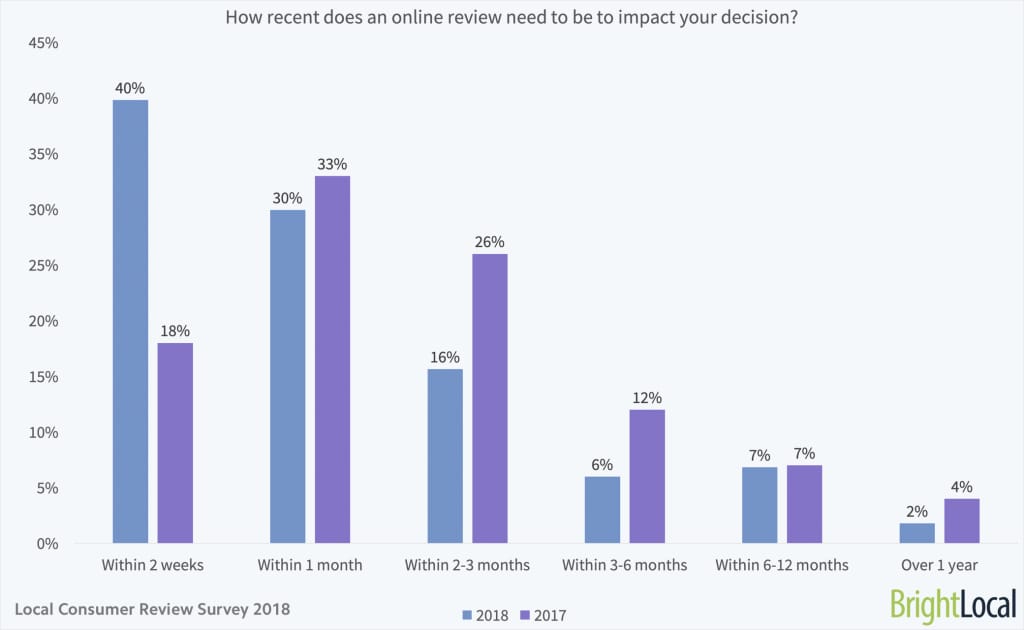
Impact of reviews on the consumer decision depending on their novelty; average indexes in 2017 and 2018. Source: BrightLocal
For example, Booking.com archive reviews older than 24 months to keep the rating score and review content relevant for the upcoming trip.
Apply classification. To attract more audience to the reviews, make it easy to navigate through them. Everybody has their own most relevant questions they want to clarify. Filtering reviews will simplify the navigation and enable users to find relevant reviews faster and easier.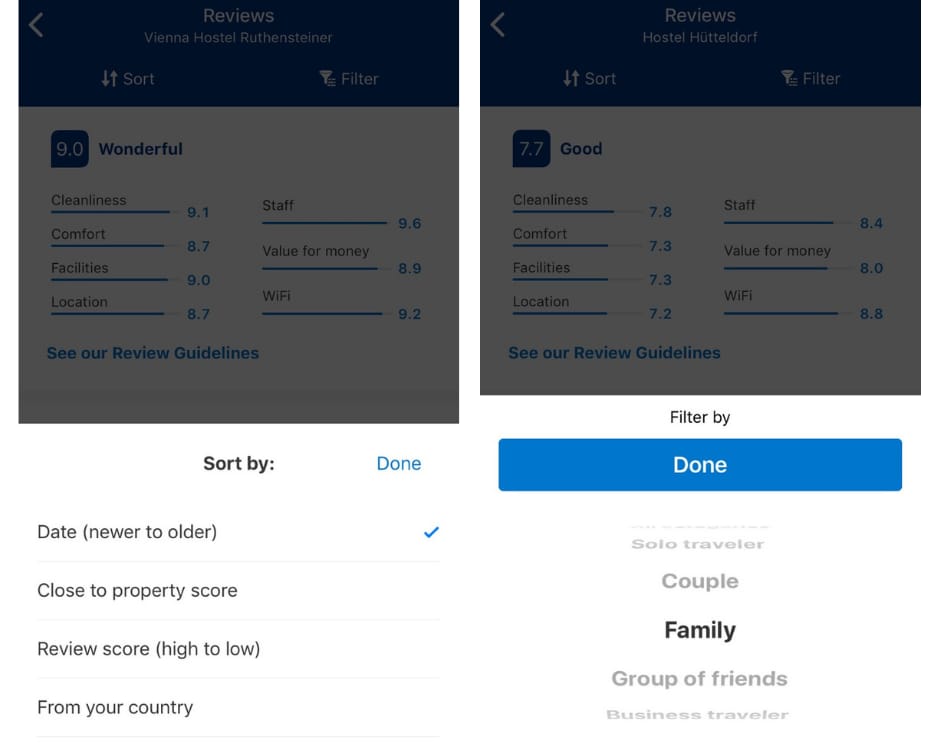
Review filtering at Booking.com
Get permission to use UGC. To avoid any potential legal hassles, always ask your customers beforehand if you are allowed to share their content on your platforms. You may include it in your terms of service agreement like Storybird, a collaborative storytelling web app, did. The third section of their agreement called “Content Contributed to the Site by Members”, automatically grants Storybird a license to use the uploaded UGC.
Reject dangerous content. To protect your website from malicious uploads, it is important to establish a list of approved file extensions that can be accepted, as well as a maximum file size. In addition, make sure the directory to which files are uploaded is outside the website root. For better defense against possible attacks, scan the uploaded files with antivirus software before opening.
Wrapping it up
So why is UGC that powerful? The answer is simple – it’s centered around users and it makes them feel appreciated. UGC triggers the powerful psychological phenomenon of social proof in which people automatically become attached to a product or service that they know others already engage with and trust.
While employing a user-generated strategy, keep the following in mind:
- Maintain an ease of contributing from a mobile device, as many users will give up if they can’t upload the content via their smartphones.
- Stick to minimalism in designing an application focused on UGC. Employ simplicity and clarity as the core factors. That way, you won’t spook users, but get them to share what they’ve been up to.
- Optimize , as UGC marketing can benefit from targeting certain customers with the content that will perform best for them.

